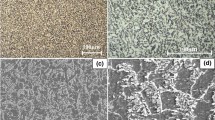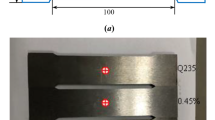Abstract
The results of studies regarding the dependence of the product of the coercive force and the initial magnetic susceptibility of a nickel single crystal with an intermediate orientation on the shear stress are analyzed. It is concluded that an increase in the aforementioned product \(\chi _{in} H_c \) for a nickel single crystal upon cold plastic deformation is due to refining of magnetic domains that is caused by formation of cells and subgrains within the single crystal. The tentative size of magnetic domains was determined based on the value of generalized magnetic parameter \({{\left( {\chi _{in} H_c } \right)} \mathord{\left/ {\vphantom {{\left( {\chi _{in} H_c } \right)} M}} \right. \kern-\nulldelimiterspace} M}_s \). The variations in the \({\chi _{in} H_c }\) product and in the calculated dimensions of magnetic domains in polycrystalline nickel are analyzed using data reported by Kersten-Gottschalt. It was also shown that, the density of dislocations being constant, the generalized magnetic parameter \({{M_{Hr} } \mathord{\left/ {\vphantom {{M_{Hr} } {\left( {\chi _{in} H_c } \right)}}} \right. \kern-\nulldelimiterspace} {\left( {\chi _{in} H_c } \right)}}\) is sensitive to changes in the sizes of nonferromagnetic inclusions, whereas in the case of small nonferromagnetic inclusions, an increase in the generalized parameter is due to an increase in the density of dislocations.
Similar content being viewed by others
REFERENCES
Bida, G.V., Issledovanie strukturnoi chuvstvitel’nosti relaksatsionnykh magnitnykh svoistv ferromagnetikov (Investigation of the Structure Sensitivity of Relaxation Magnetic Properties of Ferromagnetics), Available from VINITI, 1990, Moscow, no. 3717.
G.V. Bida T.P. Tsar’kova E.Y. Sazhina (1992) ArticleTitleMagnetic Properties Related to Reversible Processes upon Magnetization and Remagnetization in the Bending Domain Wall Model Fiz. Met. Metalloved. 1 31–35
G.V. Bida E.S. Gorkunov V.M. Shevnin (2002) Magnitnyi kontrol’ mekhanicheskikh svoistv prokata Ural Division, Russ. Acad. of Sci. Yekaterinburg
D. Kulman-Wilsdorf (1968) Dislocations R. W. Kahn (Eds) Fizicheskoe metallovedenie, tom Mir Moscow 9–86
C. Kittel (1951) Physical Theory of Ferromagnetic Domains with Spontaneous Magnetization S. V. Vonsovskii (Eds) Fizika magnitnykh oblastei Izd. Inostrannoi Literatury Moscow 20–116
M. Kersten P. Gottschalt (1940) ArticleTitleEinige Versuche Über den Einfluss von Eigenspannungen auf Koerzitivkraft und kritische Feldstärke der Barkhausensprünge Zs. f. techn. Phys. 12 345–352
M. Kersten (1943) Gründlagen einer Theorie der Ferromagnetishen Hysterese und der Koerzitivkraft Verlag Hirzel Leipzig
M. Kersten (1943) ArticleTitleZur Theorie der ferromagnetischen Hysterese und Anfangspermeablität Phys. Zs. 3/4 63–67
M. Kersten (1956) ArticleTitleÜber die Bedeutung der Versetzungsdichte für die Theorie der Koerzitivkraft rekristallisierter Werk-stoffe Zs. f. angev. Phys. 8 IssueID10 497–502
E.I. Kondorskii (1937) ArticleTitleOn the Origin of the Coercive Force and Irreversible Changes upon Magnetization Zh. Eksp. Teor. Fiz. 9-1 1117–1131
E.I. Kondorskii (1940) ArticleTitleAbout the Hysteresis of Ferromagnetics Zh. Eksp. Teor. Fiz. 10 420–440
E.I. Kondorskii (1948) ArticleTitleOn the Theory of Coercive Force of Steels Dokl. Akad. Nauk SSSR 63 IssueID6 507–510
E. I. Kondorskii (1949) ArticleTitleOn the Theory of Coercive Force of Mild Steels Dokl. Akad. Nauk SSSR 63 IssueID1 37–40
E.I. Kondorskii (1951) ArticleTitleOn the Theory of Coercive Force and Magnetic Susceptibility of Ferromagnetic Powders Depending on the Space Filling Dokl. Akad. Nauk SSSR 80 IssueID2 197–200
E.I. Kondorskii (1952) ArticleTitleOrigin of the High Coercivity of Fine-Grained Ferromagnetics in the Domain Structure Theory Izv. Akad. Nauk SSSR, ser. Fiz. 16 IssueID4 398–411
L. Neel (1944) ArticleTitleEffect des cavites et des inclusions sur le champ coercitif Cahiers de Physique 25 21–44
L. Neel (1947) ArticleTitleBases d’une nouvele theorie generale du champ coefcitif Ann. Univ. Grenoble 22 299–343
L. Neel (1947) ArticleTitleMagnetisme, le camp coercitif d’une roudre ferromagnetique cubique a grain anisotropies Comptes Rendus 224 1550–1560
L. Neel (1949) ArticleTitleNouvelle theorie du champ coercitif Physica 15 IssueID1-2 225–234
E. Schwabe (1952) ArticleTitleTheoretische Betrachtungen über die Beeinflüssung der ferromagnetischen Koerzitivkraft durch Einfküsse mit rotationseliptischer Form, für den Fall, das deren Abmessungen klein gegen die Decke der Blochwand sind Ann. d. Phys. 11 IssueID6 99–112
R. Brenner (1955) ArticleTitleErgebnisse und Probleme der quantitativen Theorie der Koerzitivkraft Zs. angev. Phys. 8 IssueID10 499–507
R. Fridberg D.I. Paul (1975) ArticleTitleNew Theory of Coercive Force of Ferromagnetic Materials Phys. Rev. Lett. 34 IssueID19 1234–1237
D.I. Paul (1982) ArticleTitleGeneral Theory of the Coercive Force due to Domain Wall Pinning J. Appl. Phys. 53 IssueID3 1649–1654
W. Prause (1979) ArticleTitleEnergy and Coercive Field of a Porous Ferromagnetic Sample with Blochwalle and Self-consistent Magnetization Magn. and Magn. Mater. 13 IssueID1-2 236–238
H. Kronmüller (1981) ArticleTitleTheory of the Coercive Field in Amorphous Ferromagnetic Alloys Magn. and Magn. Mater. 24 IssueID2 159–167
D. Siemers E. Nembach (1979) ArticleTitleHardening of Ferromagnets by Non-Magnetic Inclusions Acta Metall. 27 IssueID2 321–334
H. Träuble (1996) Magnetisirungskurve und magnetische Hysterese ferromagnetischer Einkristalle A. Seeger (Eds) Modern Probleme der Metallphysik Springer Berlin-Heidelberg-New York 157–475
J. Goodenough (1959) The Theory of Appearance of Spontaneous Magnetization Regions and Coercive Force in Poly-crystalline Ferromagnetics Magnitnaya Struktura Ferromagnetikov Izd. Inostr. Lit. Moscow 19–57
L.I. Dijkstra S. Wert (1950) ArticleTitleEffect of Inclusion of Coerzitive Force of Iron Phys. Rev. 79 IssueID6 979–985
F. Vitsena (1954) ArticleTitleOn the Relationship between the Coercive Force of Ferromagnets and Internal Stresses Czech. J. Phys. 4 419–438
F. Vitsena (1955) ArticleTitleEffect of Dislocations on the Coercive Force of Ferromagnets Czech. J. Phys. 4 480–501
Z. Malek (1957) ArticleTitleDie Abhangigkeit der Koerzitivkraft von der plastischen Deformation Czech. J. Phys. 7 IssueID2 152–168
Z. Malek (1959) ArticleTitleA Study of the Influence of Dislocations on Some of the Magnetic Properties of Permalloy Alloy Czech. J. Phys. 9 613–626
F. Kroupa Z. Malek (1959) ArticleTitleDer Einfluss der plastischnen Verformuung durch Kaltwalzen auf die Koerzitivkraft Czech. J. Phys. 9 627–637
D. Siemers E. Nembach (1979) ArticleTitleHardening of Ferromagnets by Non-Magnetic Inclusions Acta Metall. 27 IssueID2 321–234
S.V. Ivanov M.I. Kurkin V.V. Nikolaev (1990) ArticleTitleOn the Theory of the Coercive Force in Ferromagnets Fiz. Met. Metallogr. 9 53–57
V.V. Nikolaev M.I. Kurkin S.V. Ivanov (1991) ArticleTitleSpecific Features of the Cleavage of Domain Walls from Nonmagnetic Inclusions in Ferromagnets: the Axisymmetric Model Fiz. Met. Metalloved. 9 39–43
K.-H. Pfeffer (1967) ArticleTitleMikromagnetische Behandlung zwischen Versttzungen und Blochwanden Phys. Status Solidi 20 IssueID1 395–411
K.-H. Pfeffer (1967) ArticleTitleMikromagnetische Behandlung zwischen Versttzungen und Blochwanden Phys. Status Solidi 21 IssueID2 837–856
K.-H. Pfeffer (1967) ArticleTitleZur Theorie der Koerzitivfeldstarke und Anfangssuszeptiblität Phys. Status Solidi 21 IssueID2 857–872
G.V. Bida A.P. Nichipuruk T.P. Tsar’kova (2001) ArticleTitleMagnetic Properties of Steels after Quenching and Tempering. I. General. Carbon Steels Defektkoskopiya 2 3–25
G.V. Bida A.P. Nichipuruk T.P. Tsar’kova (2001) ArticleTitleMagnetic Properties of Steels after Quenching and Tempering. II. Low-Alloyed Steels Defektkoskopiya 2 26–42
G.V. Bida A.P. Nichipuruk T.P. Tsar’kova (2001) ArticleTitleMagnetic Properties of Steels after Quenching and Tempering. III. High-Chromium Steels Defektkoskopiya 2 43–56
Bida, G.V., Tartachnaya, M.V., and Sazhina, E.Yu., Issledovanie vliyaniya kholodnoi plasticheskoi deformatsii na relaksatsionnye magnitnye svoistva ferromagnetikov (Study of the Effect of Cold Plastic Deformation on Relaxation Magnetic Properties of Ferromagnets), Available from VINITI, 1993, Moscow, no. 292-93.
T.P. Tsar’kova G.V. Bida M.N. Mikheev E.S. Gorkunov (1981) ArticleTitleMagnetic Method for Testing the Quality ofHigh-Temperature Tempering of Tool and Low-Alloyed Steels Defektoskopiya 3 14–17
G.V. Bida T.P. Tsar’kova V.N. Kostin E.Y. Sazhina (1991) ArticleTitleThe Use of Relaxation Magnetic Properties for Non-destructive Testing of Quenched and Tempered Steels Defektoskopiya 12 39–44
G.V. Bida (2002) ArticleTitleMagnetic Properties of a Body as Parameters for Nondestructive Testing of the Tempering Quality of Quenched Steels (a Review) Defektoskopiya 6 19–33
G.V. Bida N.D. Pochuev A.N. Stashkov (2002) ArticleTitleNondestructive Testing of the Stress-Strain Properties of Oil Pipes Defektoskopiya 10 14–29
G.V. Bida V.M. Kamardin M.V. Tartachnaya (1993) ArticleTitleInvestigation of the Possibility of Nondestructive Magnetic Testing of Mechanical Properties of Thermostrengthened Rails Tekh. Diagnostika i Nerazrushayushchii Kontrol’ 4 42–48
G.V. Bida A.N. Stashkov (2003) ArticleTitleMultipurpose Use of Magnetic Properties of Steels in Nondestructive Testing of the Quality of Heat-Treated Workpieces Defektoskopiya 4 67–74
G.V. Bida T.P. Tsar’kova E.Y. Sazhina (1995) ArticleTitleThe Influence of Structure Changes during Quenching and Tempering on Relaxation Magnetization and Magnetic Susceptibility of High-Carbon and Low-Alloyed Steels Defektoskopiya 2 72–81
G.V. Bida E.S. Gorkunov N.F Vil’danova T.P. Tsar’kova (1999) ArticleTitleThe Influence of Nonmetallic Inclusions on the Relaxation Magnetic Properties of Ferromagnets Defektoskopiya 2 18–30
V. K. Arkad’ev (1934) Elektromagnitnye processy v metallakh. Chast’ I. Postoyannoe elektricheskoe i magnitnoe pole ONTI Moscow, Leningrad
Tsar’kova, T.P., Bida, G.V., and Kostin, V.N., Izmerenie relaksatsionnoi koertsitivnoi sily i relaksatsionnoi magnitnoi induktsii na obraztsakh razomknutoi formy (Measurements of the Relaxation Coercive Force and Relaxation Induction on Open-Shaped Specimens), Available from VINITI, 1987, Moscow, no. 7483-87.
S.V. Vonsovskii Y.S. Shur (1948) Ferromagnetizm OGIZ GITTL Moscow-Leningrad
G. Treuble A. Zeeger (1969) Vliyanie defektov kristallicheskoi reshetki na protsessy namagnichivaniya v ferromag-nitnykh monokristallakh Mir Moscow 201–264
G.E.R. Schulze (1967) Metallphysik Akademie Berlin
Seeger, A., Kronmüller, H., Mader, S., and Träuble, H., Work-hardening of Hexagonal Close-packed Crystals and in Easy Glide Region of Face-centered Cubic Crystals, Philos. Mag., 1961, pp. 639-654.
J. Virtman J.R. Virtman (1968) Mechanical Properties Inessentially Depending on Temperature R. Kahn (Eds) Fizicheskoe Metallovedenie Mir Moscow 149–215
V.N. Gridnev V.K. Gavrilyuk Yu.Ya. Meshkov (1974) Prochnost’ i plastichnost’ kholodnodeformirovannoi stali Naukova Dumka Kiev
V.V. Rybin (1986) Bol’shie plasticheskie deformatsii i razrushenie metallov Metallurgiya Moscow
A.H. Qureshi (1961) ArticleTitleExperimentelle Untersuchungen über magnetische Eigenschaften und die Ausscheidungkinetik vor Eisen-Kupper-Legirunger Zs. f. Metallkunde 52 IssueID12 799–814
G.V. Bida (2002) ArticleTitleDifferential Magnetic Method of Nondestructive Testing and Phase Analysis Defektoskopiya 1 26–43
Author information
Authors and Affiliations
Additional information
Translated from Defektoskopiya, Vol. 40, No. 7, 2004, pp. 62–76.
Rights and permissions
About this article
Cite this article
Bida, G.V. The use of generalized magnetic parameters for magnetic structural analysis and nondestructive testing. Russ J Nondestruct Test 40, 476–486 (2004). https://doi.org/10.1007/s11181-005-0007-y
Received:
Issue Date:
DOI: https://doi.org/10.1007/s11181-005-0007-y




